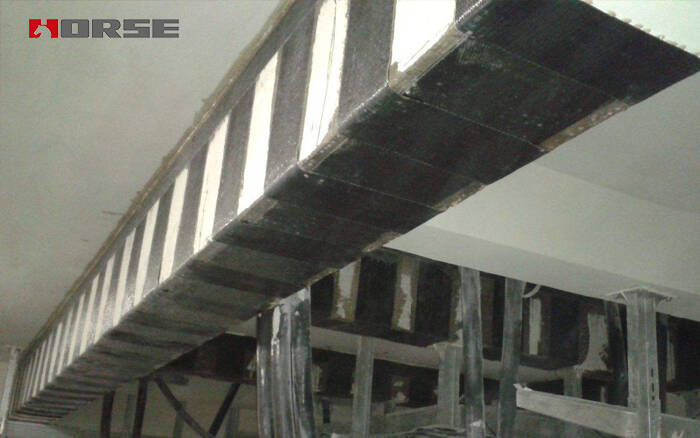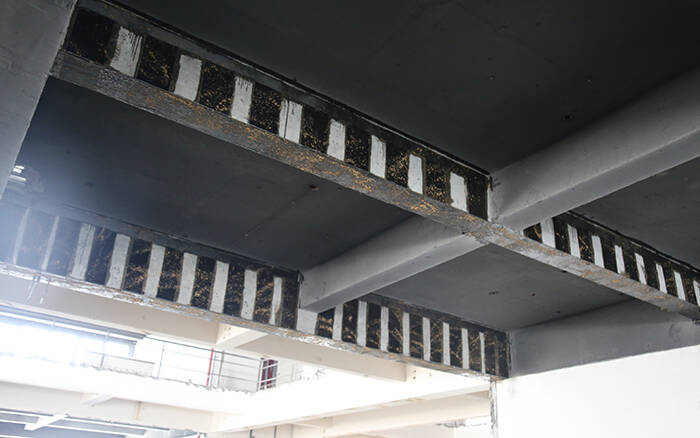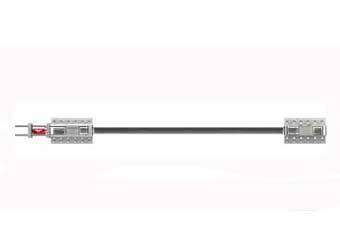Solutions
Horse Construction offers full range of structural strengthening materials with technical supports, documentation supports, products supports, project supports.
Use of Carbon Fiber Sheet in Strengthening of Concrete Structure

1 Introduction to the design and construction of unidirectional carbon fiber sheet strengthening engineering
A certain project in Dongguan is a single six-story office complex. Except for the restaurant on the fourth floor, the remaining floors are for office use. As the owner intends to change the fifth floor into an archive database, the standard value of the original floor uniform live load is 2 kN/m, which does not meet the load requirements of the ordinary archive database. After design and calculation, the beams and slabs need to be strengthened, and the standard value of uniform live load on the floor is increased to 5 kN/m2. After comparing and selecting from the physical properties of the material, the construction process and the cost of Ding Yicheng, the strengthening plan was adopted with carbon fiber sheets, and finally successfully met the requirements of use.
2 Strengthening principle of unidirectional carbon fiber sheet
Carbon fiber sheet to reinforce the building structure uses its supporting resin to stick the carbon fiber sheet on the surface of the building structure. The shear strength of the bonding resin is used to transfer the load borne by the concrete component to the carbon fiber sheet, so that the post-bonded carbon fiber sheet and the original reinforced concrete component can jointly bear the external load force.
The strengthening finally produces a superimposed force effect, and the carbon fiber sheet used for strengthening is equivalent to the strengthening of the building structure.
3 Comparison of unidirectionalcarbon fiber sheet strengthening and other materials strengthening
3. 1 Building strengthening methods and classification
The current internationally accepted building structure strengthening is divided into two categories: direct strengthening and indirect strengthening. Direct strengthening methods include enlarging section strengthening, outer steel strengthening, prestress strengthening, auxiliary structure strengthening and carbon fiber cloth strengthening. Indirect strengthening methods include the method of adding members, adding fulcrums, increasing structural integrity, and changing the stiffness ratio. According to the strengthening materials, it is divided into three categories: steel, concrete and soft materials. Carbon fiber sheet strengthening belongs to direct strengthening and soft material strengthening.
3.2 Characteristics of carbon fiber strengthening
Compared with other types of strengthening technology, carbon fiber sheet strengthening has obvious characteristics, mainly as follows:
(I) The carbon fiber material itself has relatively high specific strength and light weight. After the strengthening construction, the external dimensions of the original structure are basically not changed, and the original structure's own weight is basically not increased.
(2) The carbon fiber sheet strengthening construction process is simple, the construction period is short, and the efficiency is high.
(3) The carbon fiber material has the highest elastic modulus, and it has a better control effect on temperature cracks, rust expansion cracks and other minor deformations after strengthening.
(4) Carbon fiber sheet strengthening hardly needs wrong bolting and external compression, and it hardly damages the original structure of concrete.
(5) After the strengthening construction with the carbon fiber sheet strengthening method, there is no need to deal with the interface during the decoration construction.
(6) When the carbon fiber sheet is reinforced by double-layer or three-layer pasting, because of its thin thickness, there is almost no influence of the shear moment due to the increase in thickness, so the strengthening effect is better.
(7) Carbon fiber cloth has a unique strengthening effect on the narrow working face due to its flexibility and spoolability.
(8) Carbon fiber cloth material is an anisotropic material, and the strengthening design generally only uses its longitudinal high strength to reinforce the tensile and bending strength of reinforced concrete members. The strengthening effect is poor for compressive members and members with complex forces.
(9) Carbon fiber cloth strengthening generally cannot reinforce the rigidity of components, and the cost of strengthening with plates is higher, and its overall effect is not as good as sticking steel plates or section steel strengthening.
(10) Anti-corrosion of acid, alkali and salt medium, wide application. After strengthening, the corrosion resistance and durability of the structure can be greatly improved, and it can be applied to strengthening of components in various working environments.

4 Design of carbon fiber sheet strengthening project
4.1 Bending strengthening
4.1.1 Principles of bending strengthening
The bending strengthening of the building structure is to replace or supplement the tensile performance of the steel bar by pasting the carbon fiber cloth in the tensile area of the member, thereby improving the bending bearing capacity of the member. The design principle is that the design total bending moment after strengthening should be less than the sum of the compression bending moment of the solid body and the calculated bending moment of the carbon fiber sheet when the structural force calculation shows that the structure is damaged under compression. The moment should be less than the sum of the tensile and compression bending moment of the solid body and the calculated bending moment of the carbon fiber sheet.
4.1.2 Bending strengthening method
(1) Adopt multiple densely distributed carbon fiber boards in the bending moment area of structural beams and plates. When reinforcing in the positive bending moment zone, the carbon fiber sheet should extend to the edge of the support. When the carbon fiber sheet extends to the edge of the support and still does not meet the requirements, uranium consolidation measures should be taken. When strengthening in the negative bending moment area, it is arranged according to the specification according to the negative bending moment distribution and the slab is not less than 1/4 span and the beam is not less than 1/3 span.
(2) In the calculation, the shear of the structure should be checked to meet the design requirements to avoid the occurrence of shear failure before bending failure.
(3) Bending strengthening should generally adopt U-shaped chicks (on beam) through long bead (on board) or other reliable mechanical tracing methods within the extension length of the sheet to ensure that the force meets the requirements.
4.2 Shear strengthening
4. 2.1 Principles of shear strengthening
The shear strengthening of building structures is generally designed for the shear area of beam-column nodes. The general design principle is that the target shear design value is less than or equal to the sum of the original building structure shear value and the carbon fiber sheet converted shear value.
4.2.2 Shear strengthening method
(1) The direction of the carbon fiber sheet during shear strengthening should be perpendicular to the longitudinal axis of the member.
(2) Shear strengthening generally adopts the method of pasting ring-shaped chicks, U-shaped hoop and double L-plate U-shaped hoop in the sheared area of the structure. U-shaped hoop and double-L-plate U-shaped hoop should be supplemented with double-side pressure strips to enhance the tracing force.
4.3 Seismic strengthening of columns
4.3.1 Principles of seismic strengthening of columns
The seismic strengthening of the column is controlled by the total converted volume strengthening ratio. That is to say, the total converted strengthening ratio is calculated based on the strengthening ratio calculated by the core section volume of the structural stirrup plus the carbon fiber sheet conversion ratio. The calculated structural column force can meet the requirements of the concrete structure design code for seismic column strengthening ratio.
4.3.2 Seismic strengthening methods of columns
The seismic strengthening of the column adopts the method of circumferentially binding carbon fiber sheets. The carbon fiber sheets should be arranged continuously in the strengthening area of the young strengthening. The lap length of the sheet strips should not be less than 150 mm, and the lap joints should be staggered.
Concluding remarks
(1) The strengthening design of carbon fiber sheets assumes that the strength of the bonding resin meets the design requirements, the section strain maintains a plane strain, and each material is stressed within the allowable strain range. The sheet is passively stressed after the initial strain of the structure. Different strengthening objects have different strengthening effects due to different initial stresses and different engineering environments. Special attention should be paid when designing and using parameters. Later, the study of the stress-strain relationship between the structure and the sheet should be strengthened.
2) During construction, the treatment of structural foundation, the preparation of bonding materials, and the skill level of construction personnel also have a greater impact on the strengthening effect, so strict design requirements must be organized to organize construction.
(3) Restricted by the complexity of construction conditions and the depth of theoretical research, the current specifications need to be further improved.
(4) This strengthening method is generally applicable to general bending and tension members that bear static forces in house buildings and general structures, and can also be applied to the strengthening of masonry structures, wood structures and steel structure members. It is not suitable for use in compression members, members with insufficient rigidity, and structural members under dynamic load.
You can find anything here you are in need of, have a trust trying on these products, you will find the big difference after that.

High strength carbon fiber reinforced polymer (CFRP) strip / laminate / plate for structural strengthening and concrete repair

Prestressed carbon fiber reinforced polymer(CFRP) plate for slab, beam strengthening to increase stiffness, reduce distortion and deflection of members, reduce the cracks, avoid and stop cracking.

High strength, unidirectional carbon fiber sheet pre-saturated to form a carbon fiber reinforced polymer (CFRP) sheet used to strengthen structural concrete elements.